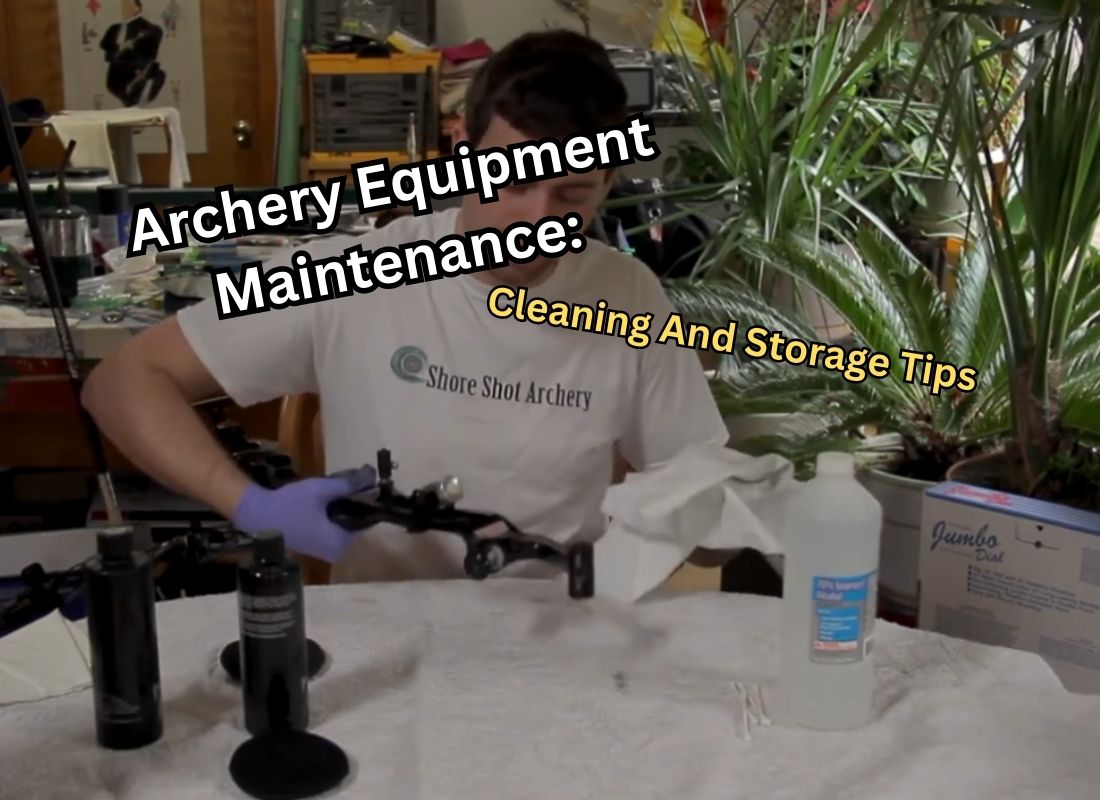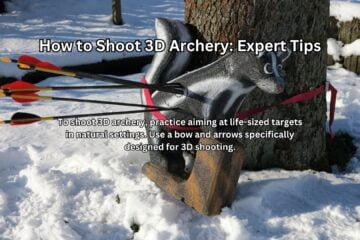Proper cleaning and storage of archery equipment prolong its lifespan. In this article, we will discuss the essential archery equipment maintenance tips that will help you keep your gear in top-notch condition.
Archery is a sport that requires accuracy, speed, and precision. And to achieve these, it is vital to maintain your archery equipment correctly. The equipment maintenance tips we are about to discuss are for both beginners and experienced archers. Whether you compete or hunt, following these maintenance routines will help you avoid costly equipment replacement or repairs.
Proper storage and cleaning of your archery gear are essential to prevent wear and tear, rust, and damage. Let’s dive in and explore these archery equipment maintenance tips for optimal performance.
Pre-Cleaning Preparation
Archery Equipment Maintenance: Cleaning And Storage Tips
Archery is a great sport that requires proper maintenance of equipment to ensure their longevity and functionality. Whether you are a beginner or a pro, cleaning and storing your archery equipment correctly is essential for successful archery practise.
Gathering Equipment And Materials
Before you start cleaning your archery equipment, you must gather the necessary materials to avoid interruptions during the process. You will need:
- A clean, soft cloth
- String wax
- Bowstring cleaner
- Bowstring wax
- Arrow lube
- Soap and water
Finding An Appropriate Workspace
It is crucial to select an appropriate workspace to clean and maintain your equipment. You should find a quiet location that is free from dust, dirt, and moisture. Ideally, the workspace should have natural light and adequate ventilation.
Disassembling Equipment
Disassembling your archery equipment will make the cleaning process simpler, and you will clean each component correctly. Remove the arrowheads, nock, quiver, stabilizer, sight, and any other attachments safely. Make sure to label each part to make it easier to reassemble equipment later.
Remember that proper archery equipment maintenance involves cleaning and storage tips. Consider the above guidelines to keep your archery equipment in top condition for optimal performance. With a little bit of care, you can enjoy successful archery practice and fun for years to come.
Cleaning Your Archery Equipment
Archery Equipment Maintenance: Cleaning And Storage Tips
Archery is a sport that requires a lot of focus, skill, and patience. However, it’s not just about your technique; taking care of your archery equipment is also crucial. You want your gear to last long and remain in top condition.
One way to do this is through proper cleaning and storage. In this section, we’ll be discussing how to clean your archery equipment, including your bow, arrows, and other accessories.
Cleaning Your Bow: Step-By-Step Instructions
Cleaning your bow may look like a daunting task, but it’s a straightforward process. Here’s how to do it step-by-step:
- Gather all the materials you need, including a soft cloth, rubbing alcohol, and string wax.
- Wipe all the dust and dirt off your bow with a soft cloth. For hard-to-reach areas, use a soft-bristled brush.
- Dampen a new cloth with rubbing alcohol and use it to wipe the bow’s limbs. Be sure to avoid the grip area.
- Apply string wax to the bowstring. Rub it gently with your fingers until it’s evenly distributed throughout the string.
- Wipe off any excess wax with a clean cloth.
Cleaning Your Arrows: Step-By-Step Instructions
It’s essential to keep your arrows clean and free from any dirt or debris. Doing so can prevent damage and make your arrows last longer. Here’s how to clean them:
- Inspect your arrows for any signs of damage. If there are any cracks or chips, discard the arrow.
- Wipe off any dust or debris with a soft cloth or a feather duster.
- Dampen a new cloth with rubbing alcohol and use it to wipe the arrows down thoroughly.
- Inspect the nocks and points for any damage or debris. Clean them with a soft cloth and rubbing alcohol if necessary.
Cleaning Your Other Equipment (E.G. Quiver, Release Aid): Step-By-Step Instructions
Cleaning and taking care of your other archery equipment, such as your quiver and release aid, is just as essential as taking care of your bow and arrows. Here’s how to do it:
- Empty your quiver, then wipe the inside with a damp cloth.
- Remove any dirt or debris from your release aid with a soft cloth.
- Check the release aid’s jaws, trigger, and other parts for any damage or wear. Clean them with rubbing alcohol if needed.
- Store your equipment in a dry and secure place, away from direct sunlight and moisture.
Taking care of your archery equipment doesn’t have to be a chore. With these easy-to-follow cleaning and storage tips, you can ensure your gear stays in top shape for years to come.
Drying And Oiling Your Archery Equipment
Archery Equipment Maintenance: Cleaning And Storage Tips
Maintaining your archery equipment is a crucial part of ensuring great performance and safety. Properly cleaning and storing archery equipment can ensure the longevity of the components. One essential component of equipment maintenance is drying and oiling your archery equipment.
Here are some tips to ensure your equipment is well-maintained.
Importance Of Drying Archery Equipment
Your equipment can quickly accumulate moisture, which may lead to rusting, corrosion, and other types of damages. The presence of moisture is prevalent in equipment that is used outdoors and in humid environments.
Here are the main reasons why you should dry your archery equipment properly:
- Drying your equipment is crucial to preventing moisture from building up and causing damages.
- Moisture buildup may cause rusting or corrosion, and regular drying prevents that.
- Drying equipment helps prevent mildew growth and bacteria build-up, which are harmful to your equipment and your health.
Step-By-Step Instructions For Drying Your Equipment
Here are the step-by-step instructions for drying your archery equipment:
- Remove the bowstring from the bow carefully.
- Inspect the bow limb and riser for any signs of moisture.
- Clean any moisture or debris using a soft cloth or towel.
- Find a dry and well-ventilated area that is out of direct sunlight and with low humidity level.
- Wipe the string, limbs, and riser with a dry cloth or towel, and make sure they are completely dry.
- Hang the bow vertically in a cool and dry area, and let it dry for at least an hour.
When To Oil Your Equipment
Archery equipment needs proper lubrication to ensure smooth operation and extend its lifespan. Oil is fantastic for providing lubrication to various parts of your equipment, such as the bowstring, bow limb, and other metal parts.
Here are the main signs indicating that your archery equipment needs oiling:
- You notice that your equipment is making noise or squeaking while in use
- The bowstring looks dry and appears to have frayed areas
- The bow limb and physical components look dull and lack vibrancy
Step-By-Step Instructions For Oiling Your Equipment
Here are the step-by-step instructions for oiling your archery equipment:
- Gather the required equipment, which includes bowstring wax, and oil for the limbs and other metal parts.
- Remove the bowstring from the bow.
- Apply a tiny amount of wax to the bowstring and rub it in gently.
- Apply a light coat of oil to the bow limb, focusing on the area where the string comes into contact.
- Use a soft cloth or towel to wipe off any excess oil.
- Apply a light amount of oil to other metal components.
- Rub the oil lightly into the metal parts, ensuring that no excess is left behind.
- Wipe away excess oil with a soft cloth or towel.
Properly maintaining archery equipment can extend its lifespan and ensure smooth operation, which is essential for any hunter or archery enthusiast. By following the above drying and oiling tips, you can prevent damages and rusting while preserving your equipment’s equipment and lifespan.
Storing Your Archery Equipment
Archery Equipment Maintenance: Cleaning And Storage Tips
Maintaining archery equipment is essential for safe and accurate shooting. Cleaning and storage are two crucial aspects of equipment maintenance. In this blog post, we’ll focus on storage and provide tips to help you store your archery equipment correctly.
Choosing An Appropriate Storage Location
Choosing an appropriate storage location is crucial to ensure that your equipment remains undamaged and safe. Below are the key points to consider.
- Choose a dry and cool storage area to prevent exposure to moisture and heat.
- Avoid high-traffic areas to prevent accidental damage to your equipment.
- Make sure your storage area is away from direct sunlight to prevent color fading and deterioration.
- Keep your storage area locked and inaccessible to children or unauthorized people.
How To Safely Store Your Bow
Storing your bow correctly is essential for its durability and performance. Below are the key points to consider.
- Clean your bow thoroughly before storing it to remove any sand, dirt, or debris.
- Remove the bowstring and any attachments, such as stabilizers or sights.
- Store your bow in a hard case or soft case to protect it from dust, moisture, and physical damage.
- Store your bow in a vertical position to prevent bending and warping.
How To Safely Store Your Arrows
Storing your arrows correctly is paramount to ensure they remain undamaged and retain their performance. Below are the key points to consider.
- Remove any debris, such as dirt or grease, from your arrows before storing them.
- Store your arrows in a quiver or arrow case to protect them from dust, moisture, and physical damage.
- Store your arrows in a dry, cool, and well-ventilated area to prevent exposure to heat, humidity, and moisture.
- Do not store your arrows horizontally, as this can cause bending and warping.
Storing Other Equipment
Apart from your bow and arrows, you may have other equipment that requires proper storage. Below are the key points to consider.
- Clean your quiver and other equipment before storing them to remove any debris or dirt.
- Store your quiver, targets, and other equipment in a dry and cool area to prevent exposure to heat and moisture.
- Keep your targets in a protected and well-ventilated area to prevent fading or deterioration.
- Ensure that your quiver and other equipment are secured and not in a high-traffic area or accessible to unauthorized people.
Storing your archery equipment correctly is essential for its durability, safety, and performance. Follow the tips outlined above to ensure that your equipment remains undamaged and safe for your next archery session.
Tips For Maintaining Archery Equipment
Keeping your archery equipment in good condition is essential for continued precision and accuracy when shooting. Regular maintenance helps to lengthen the lifespan of your gear and reduces the need to replace them frequently. Below are some tips for maintaining your archery equipment.
Frequency Of Maintenance
Archery equipment requires consistent maintenance, especially after each use. However, the frequency of maintenance depends on the equipment’s use, environmental conditions, and storage. Below are the recommended times for maintaining your equipment:
- Bows: Wipe down after each use, and tune-up every 3-6 months or as soon as you notice changes in accuracy and performance.
- Arrows: Check for damages and straightness after each use and replace as needed. Re-fletch every three months.
- Strings and cables: Wax it after each use_,_ and replace them every year or if they begin to fray.
- Accessories: Check for wear and tear regularly, especially before using them.
Signs That Equipment Needs Maintenance
Knowing what to look out for helps you promptly identify equipment issues and prevent them from worsening. Here are some signs that indicate your archery equipment needs maintenance:
- Bows: Poor accuracy, unusual sounds, twisted limbs, or visible cracks indicate that the bow needs maintenance.
- Arrows: Bent arrows, flattened nocks, and cracked shafts need replacement.
- Strings and cables: Fraying, flattening, or breaking strings or cables mean they need replacement.
- Accessories: Damaged quivers, sights, and stabilizers need repair or replacement.
Common Mistakes To Avoid
Avoiding common mistakes helps you keep your archery equipment in good condition and avoid expensive repairs and replacements.
- Not wiping down your equipment after use. Leaving moisture and dirt on your equipment damages them.
- Overwaxing the bowstring. Applying too much wax can attract debris and prevent optimal usage. Only apply a light coat.
- Dry firing the bow. Firing without an arrow can cause damage to the bow limbs and accessories.
- Storing the bow in extreme temperatures. Extreme heat or cold can cause the limbs to twist, causing damages.
- Neglecting equipment inspection. Regular inspection helps identify issues and correct them before they become irreparable.
Benefits Of Regular Maintenance
Frequently maintaining your archery equipment comes with several benefits, including:
- Improved performance and accuracy. Regular maintenance ensures your equipment is in optimal condition, which improves accuracy and ease of use.
- Extending the lifespan of your equipment. Regular maintenance prevents damages and wears, reducing the need to replace gear frequently.
- Saving money. Repairing and replacing damaged equipment is costly. Regular maintenance helps you avoid these expenses.
- Increased safety. Well-maintained equipment minimizes accidents and injury, ensuring your safety and the safety of others.
Maintaining your archery equipment regularly is crucial for achieving consistent accuracy and improving your performance. Following these tips helps you keep your archery equipment in good condition.
Frequently Asked Questions Of Archery Equipment Maintenance: Cleaning And Storage Tips
How Often Should I Clean My Archery Equipment?
It’s recommended to clean your archery equipment after every use or every other use to prevent dirt, dust, and debris buildup on your equipment. Proper cleaning can extend the life of your equipment and keep it functioning properly.
How Do I Clean My Arrows?
To clean arrows, use a soft cloth and warm water with mild soap or detergent to gently wipe away dirt and debris. Avoid using harsh chemicals or abrasive materials on your arrows, as this could damage the shaft or fletching.
How Should I Store My Bow?
Store your bow in a dry location to prevent moisture damage. You can use a bow case, rack, or other protective storage solution to keep your bow safe and prevent it from being exposed to extreme temperatures or humidity.
How Do I Maintain My Bowstring?
Regularly check your bowstring for signs of wear and tear, such as frayed or loose strands. To maintain your bowstring, apply bowstring wax or conditioner every few weeks to keep it supple and prevent it from drying out or becoming brittle.
Can I Oil My Bow?
It’s not recommended to use oil on your bow, as this can damage the finish or cause the wood to swell. Instead, use a specialized bowstring wax or conditioner to maintain your bow’s finish and keep it protected from moisture and other elements.
Conclusion
Maintaining your archery equipment is vital for ensuring its longevity and your own safety. Regular cleaning and proper storage can prevent potential damages and minimize the risk of accidents. By following the aforementioned tips, you can keep your equipment in excellent condition and ready for use whenever required.
Remember to inspect your gear for damages and wear and tear regularly to avoid any unexpected issues. Additionally, it is essential to have a well-equipped toolkit at your disposal to carry out minor repairs and adjustments. Take care of your archery equipment, and it will take care of you.
With the right care, your gear will serve you for years to come, providing a fulfilling and enjoyable archery experience. Let’s embrace these guidelines together and keep our bows and arrows in top-notch condition.







